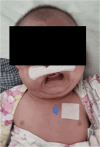Analgesic Potential Comparison Between Piperine-Combined Curcumin Patch and Non-Piperine Curcumin Patch: A Pragmatic Trial on Post-Cleft Lip/Palate Surgery Pediatric Patients
- PMID: 38812820
- PMCID: PMC11135569
- DOI: 10.2147/JPR.S463159
Analgesic Potential Comparison Between Piperine-Combined Curcumin Patch and Non-Piperine Curcumin Patch: A Pragmatic Trial on Post-Cleft Lip/Palate Surgery Pediatric Patients
Abstract
Purpose: Despite its well-acknowledged analgesic potential, curcumin's low bioavailability has been recognized. Piperine, a substance naturally contained in pepper, has been known for its effect on increasing curcumin bioavailability. To investigate the analgesic potential of curcumin and piperine addition to curcumin patch used as adjuvant therapy in the management of acute postoperative orofacial pain.
Patients and methods: This pragmatic trial recruited 75 patients that underwent oromaxillofacial surgery at Unpad Dental Hospital, Bandung, Indonesia. Research participants were randomly assigned to three different groups: the first group that did not receive any intervention other than the post-operative standard treatment (POST), the second group that received POST and non-piperine curcumin patch, and the third group that received POST and piperine-combined curcumin patch. Participants' pain intensity was evaluated by using the face, leg, activity, cry, and consolability (FLACC) pain scale and salivary prostaglandin-E2 (PGE2) level for two-time points, which were eight hours apart. All data were gathered and analyzed to compare the within and between-group differences.
Results: Within groups comparison of the FLACC scores for two evaluation points showed significant differences for all groups (p < 0.01). For salivary PGE2 analysis, a comparison of the non-piperine group to the piperine group also showed significant results. Yet, when all three groups were compared, regardless of the differences, the results were not statistically significant.
Conclusion: Despite of the proven efficacy of curcumin patch, the addition of piperine to the curcumin patch in the current study did not provide any significant effects. Further investigation is of importance.
Keywords: acute postoperative pain; cleft lip; cleft palate; curcumin; oromaxillofacial surgery; piperine.
© 2024 Maulina et al.
Conflict of interest statement
The authors report no conflict of interest in this work.
Figures





Similar articles
-
The Efficacy of Curcumin Patch as an Adjuvant Therapeutic Agent in Managing Acute Orofacial Pain on the Post-Cleft Lip and Cleft Palate Surgery Patients: A Pragmatic Trial.Eur J Dent. 2023 May;17(2):411-417. doi: 10.1055/s-0042-1750802. Epub 2022 Sep 12. Eur J Dent. 2023. PMID: 36096139 Free PMC article.
-
Effect of curcumin-pipeine supplementation on clinical status, mortality rate, oxidative stress, and inflammatory markers in critically ill ICU patients with COVID-19: a structured summary of a study protocol for a randomized controlled trial.Trials. 2021 Jul 6;22(1):434. doi: 10.1186/s13063-021-05372-9. Trials. 2021. PMID: 34229742 Free PMC article.
-
Effect of Piperine on Skin Permeation of Curcumin from a Bacterially Derived Cellulose-Composite Double-Layer Membrane for Transdermal Curcumin Delivery.Sci Pharm. 2018 Sep 13;86(3):E39. doi: 10.3390/scipharm86030039. Sci Pharm. 2018. PMID: 30216984
-
Curcumin-piperine co-supplementation and human health: A comprehensive review of preclinical and clinical studies.Phytother Res. 2023 Apr;37(4):1462-1487. doi: 10.1002/ptr.7737. Epub 2023 Jan 31. Phytother Res. 2023. PMID: 36720711 Review.
-
A Unifying Perspective in Blunting the Limited Oral Bioavailability of Curcumin: A Succinct Look.Curr Drug Metab. 2022;23(11):897-904. doi: 10.2174/1389200223666220825101212. Curr Drug Metab. 2022. PMID: 36017834 Review.
References
-
- Tasman SGR, Putri FA, Maulina T. Validation of the Indonesian Version of the Face, Legs, Activity, Cry, Consolability (FLACC) scale in postoperative cleft lip and/or cleft palate patients. Open Dent J. 2022;16:1–6.
-
- Augsornwan D, Pattangtanang P, Pikhunthod K, Surakunprapha P. Postoperative pain in patients with cleft lip and palate in srinagarind hospital. J Med Assoc Thai. 2011;94(Suppl 6):S118–23. - PubMed
-
- Pérez EV, Lizama GR, Cárdenas VG. Current trends and new strategies in acute postoperative pain management in children. Medic Res Arch. 2021;9:9. doi:10.18103/mra.v9i9.2539 - DOI
-
- Moura LA, Pereira LV, Manamisava R, Borges NC, Castral TC, Souza LAF. Severe acute postoperative pain self-reported by children after ambulatory surgeries: a cohort study. Rev Bras Enferm. 2021;74(Suppl 4):2. - PubMed
LinkOut - more resources
Full Text Sources

